Facing Pipeline
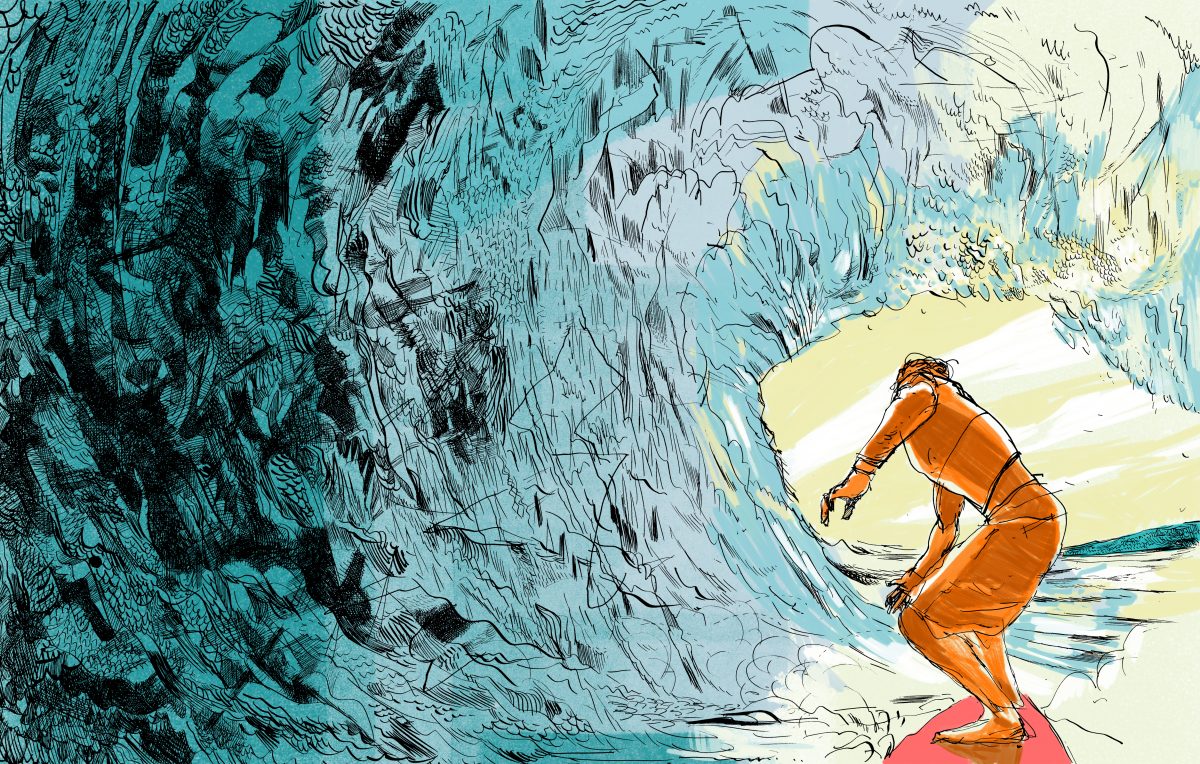
Eleven accomplished surfers recall their first encounters with the world’s most dangerous wave.
Interviews conducted by Alex Roth and Dan Fitzpatrick
Joyce Hoffman
First known woman to surf Pipeline; won two world championships in the 1960s
I was the first woman to surf Pipeline. To be perfectly honest, I basically went out because Bud Browne was on the beach filming and he told me if I went out he could film it and it would be history. So I swallowed hard and put on my best game face and figured I’d do it. I was definitely afraid and probably wouldn’t have gone out at that time if Bud hadn’t been there and given me that extra little push. I just sort of figured, what the hell, I’ve surfed bigger surf than that. I’d be out at Makaha when it was 15 or 18 foot. I’d been out at Sunset when it was 12 or 15 foot.
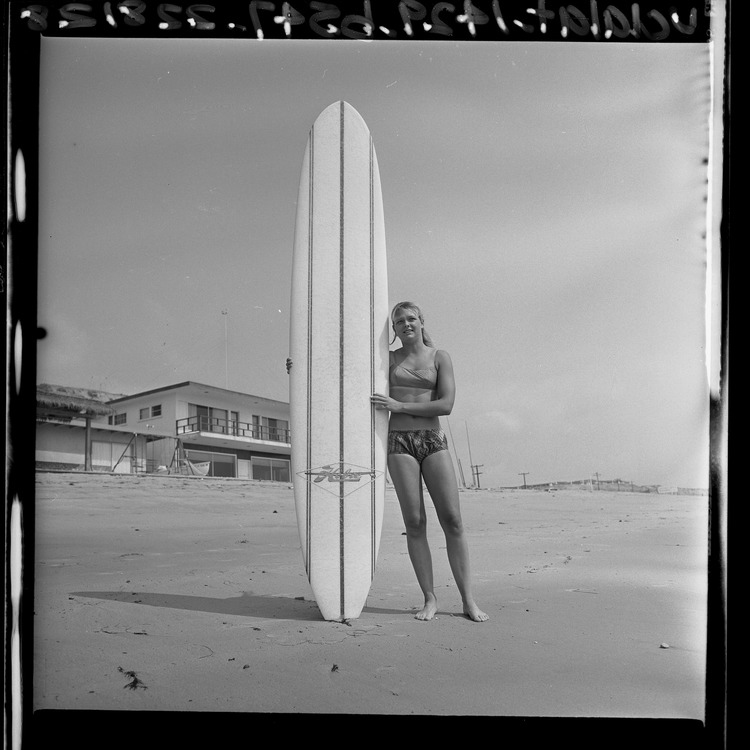
Joyce Hoffman: “I was definitely afraid.” Photo: UCLA
Of course, the size is not the main issue at Pipeline. It’s the power of the wave and how shallow it is over those reefs. I was probably on a 9-6 Hobie, a Phil Edwards-type board. It was probably 1964, maybe 1965. The surf seemed friggin humongous but it was probably four feet with eight-foot sets. On the same day, before I went out, Bob Pike from Australia had bounced off the bottom and came in with his shoulder cut open and his ear half-way sliced off. And I’m there with my family – my mom and my dad – and I remember my mom being pretty upset and worried that I was going to be paddling out there into God knows what. But it went ok. I caught some waves and fortunately there wasn’t a big crowd out there – not like there is today – and the guys that were out there were guys that I knew, because you kind of knew everybody back in those days.
“I swallowed hard and put on my best game face.”
So it was a very friendly crowd that gave me space to take off on whatever wave I felt comfortable taking. At one point, I got stuck in the rip and Phil Edwards actually came over and helped paddle me in. I wanted to be the first. If it wasn’t going to be me, it was going to be somebody soon. At the end, I think I was feeling very relieved that I conquered my fears and nothing bad happened. And I was very grateful that Bud Browne was there and caught it on film. Timing is everything.
Liam McNamara
North Shore local who became fiery 1990s fixture at Pipeline
When I was kid in like 1982, 1983, I snuck out of school and got to watch the Pipe Masters and was completely amazed by it. If dreams were to come true, this was going to be a wave I’d attempt to ride. I actually witnessed one guy smash his head on the reef, another guy got his knee torn apart. So I was aware of the dangers, I was aware that you were risking your life. I was a kid who had a dream of being a Pipeline surfer, a North Shore surfer, making a name for myself.
Around 1985, when I was 16, I first started surfing there on the smaller days and probably went out on a few decent-size days. I was told by my elders that I would never be able to ride Pipeline because I get up to my feet rather slow. They called me the one-step, two-step. I took that to heart.
My first year of charging big waves at Pipeline was 1986. I remember definitely being scared. Anybody who surfs Pipeline, anybody who surfs big waves, if they tell you they’re not scared, they’re lying to you and they’re lying to themselves. It’s a matter of taking that fear and adrenaline and turning it into motivation. So I remember at first trying to sit a little bit in the safety zone, although in reality there’s not much of a safety zone once you’re out there. I do remember getting my first tube rides out there and it’s a feeling that’s very hard to describe but it was a feeling I wanted a lot more of – making the drop, which is the heaviest part of the whole thing, and then pulling into the tube and enjoying being inside Mother Nature’s womb and then getting spit out of a barrel. Time slows down when you’re in the barrel. It’s the ultimate place to be – you’re inside the curl of a wave, nobody can see you, you can’t see anybody. When you get spit out of a barrel at Pipeline, it’s like a fire hose blowing on you. It’s like needles hitting your face because the spray and spit is so powerful. You have to close your eyes a lot of times when you’re coming out. The spit hurts, but it’s a good hurt. Any good wave at Pipeline spits.
“Go deep, put your head down, paddle hard and whatever you do, don’t pull back. And whatever you do, don’t say a word and just go.”
The crowd can be even more intimidating at Pipeline. You’re in the limelight. You’re at the 50-yard line. You’re in the Super Bowl. Everybody’s watching. If you drop the pass, people will know. You gotta earn stripes out there. When I first started surfing Pipeline in the 80s, that was the decade that would be remembered as the heaviest decade with the heaviest legends. I dealt with the Who’s Who of the Hawaiian warrior legends – Dane Kealoha, Michael and Derek Ho, Tony Moniz, Max Medeiros, Marvin Foster, Johnny-Boy Gomes, Gerry Lopez. If you paddled for a wave and even chirped a word out of your mouth, if even half a whisper came out of your mouth, you’d probably wished you never did say a word because you’re disrespecting your elders. You don’t hoot at locals. If you do, you’re disrespecting them. So what I did was I paddled 100 feet deeper, 200 feet deeper than everyone in the lineup. Go deep, put your head down, paddle hard and whatever you do, don’t pull back. And whatever you do, don’t say a word and just go.
Mark Healey
It was me, Jamie O’Brien, Jason Frederico and Danny Fuller and it was all of our first times going out. We camped on the beach so we could be paddling out in the dark just because there’s no wave we could get waves otherwise. When you’re young, it’s just a scary lineup. That was back when things were a lot rougher. You’d see guys getting their face punched in every other day. You could be a kid and get your ass kicked by a grown man just for being in the way.
“You could be a kid and get your ass kicked by a grown man just for being in the way.”
So we were trying to get our first little experience in before anybody showed up. It was probably four to six feet. We all surfed it together. The velocity of the wave is so different to anything even on the North Shore. It’s a lot more power. You have to get to your feet a lot faster. So everybody was kind of nervous. Jamie broke his board. It was the first time any of us had ever seen a friend break his board. It was like, “Woah, he broke a board at Pipeline,” you know? I think I just got pitched a few times and then we ended up going in.
Shaun Tomson
South African native who won Pipe Masters in 1975, world championship in 1977
The first time was 1970. I was 15. Back then, no one rode it when they were young. In South Africa, I had a picture above my bed of John Peck surfing Pipeline in a crouch, and I knew that was the path – Pipeline was the path for me. I always understood that Pipeline was the road to greatness for a surfer, and still is. Unless you can be great at Pipeline, you’ll never be great.
A few years earlier a Peruvian surfer named Joaquin Miro Quesada had died at Pipeline and it had been in the magazines and I’d read about it and there had been a picture of him just before he was killed. So it always stuck in my consciousness that if you make a mistake there, it could kill you. So I was very nervous during my first surf there and sitting more on the shoulder. I saw a guy on a kneeboard take off on a wave and as he’s dropping down on the wave, the wave was lifting him up and he was going up backwards against the force of gravity and it threw him upside down like 15 feet away from where I was sitting. It shocked me to my core to see a wave that had so much force. And it smashed him right into the reef and he walked up the beach bloodied and broken. Welcome to the reality of the Banzai Pipeline, where down is up. I caught a few, but very gingerly, very tentatively. For me it was a process. It wasn’t like you go out, you catch one wave and that’s it, you’ve conquered your fears. It took a few years to find my footing.
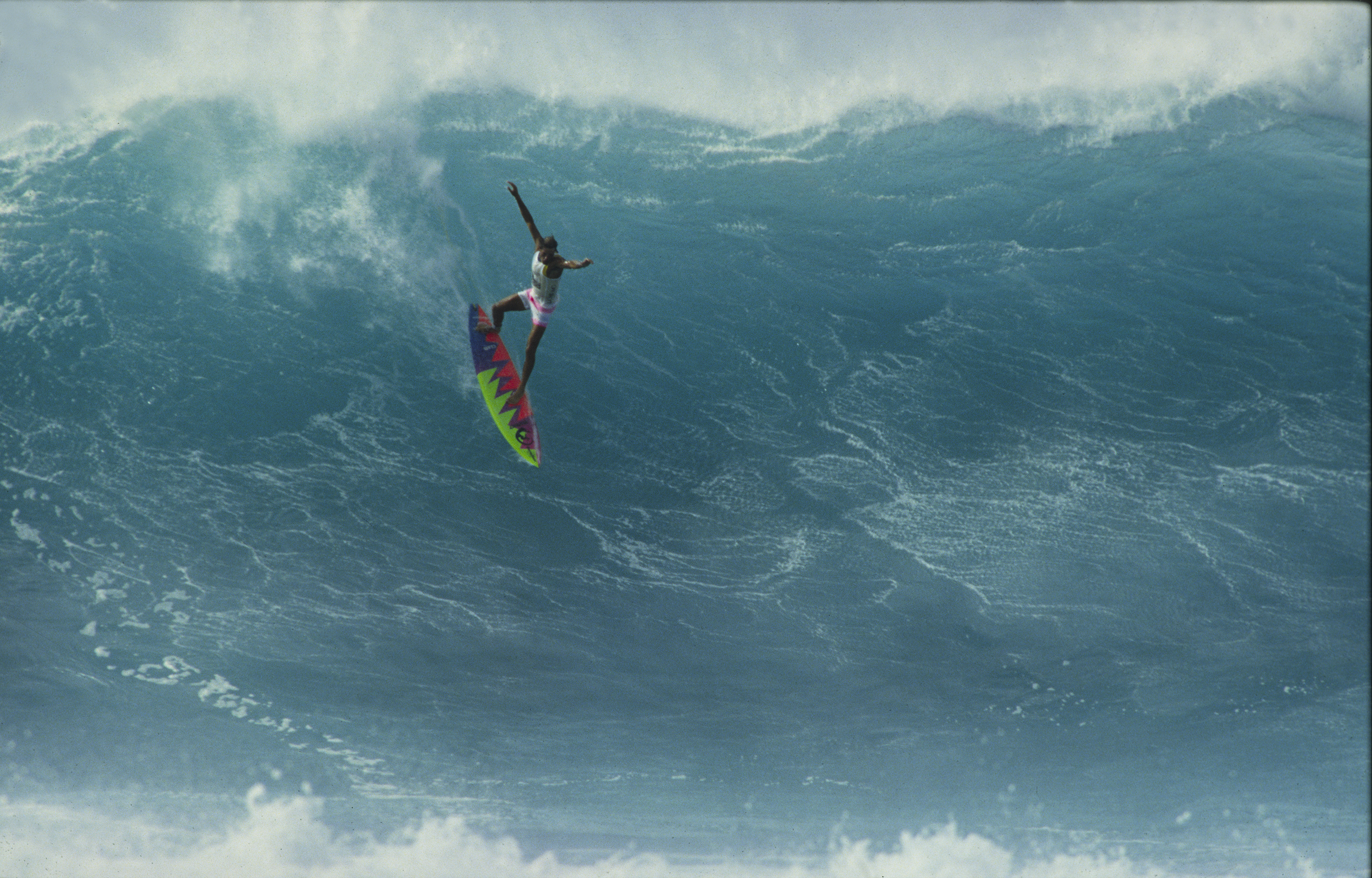
Shaun Tomson drops into Pipe. Photo: James Cassimus
It wasn’t until I spent an entire season on the North Shore in 1974 that I really found my confidence. That was when I was 19. I do remember paddling out that season and a guy saying to me, “Better not drop in on me or you’re going home in a box.” I also had what turned out to be a really great board made by my shaper in South Africa, Spider Murphy. I rode that board for five winters and during those five winters I was surfing Pipeline as hard and as radically as it can be surfed and I never, ever lost it on take-off, not once. That board was magic.
“It shocked me to my core to see a wave that had so much force.”
The last time I surfed Pipeline was in 2005 and the last wave was about a 10-foot wave at Backdoor, I was deep in this barrel, thinking man, I’ve got this made, it’s like 1977 all over again. Next thing I was on my back, on the reef, with my board smashing into me so hard that I saw stars and broke my nose open. I had two black eyes and a broken nose and that’s the last time I’ll ever surf there. It’s for the young and aggro.
Jamie O’Brien
North Shore local known for his Pipeline expertise; won the Pipe Masters in 2004
I think I was about seven and my dad was like, now’s the time. He bought a helmet for me to make sure I was extra safe. It was small surf so I wouldn’t say it was real-deal Pipeline, but when you’re seven years old, it was real-deal Pipeline. But then, when I was a little older, me and Mark Healey and a couple guys went out when it was like, oh, shit, this is the real-deal Pipeline. I think I was 11 or 12. It was the first big day that any of us had been out there. We weren’t sure if we were supposed to be out there or not. The lifeguards didn’t really say anything. I just remember we were all real scared, real timid, not knowing the right or wrong things to do in the lineup. I remember getting really pounded that day. Johnny-Boy Gomes told me to go on this wave and I broke my board in three pieces and I was just really discouraged and not sure if I liked it. It was pretty crazy. I just remember Johnny-Boy telling me, “Go! Go!” and I think at the end of the day what I realized is that it wasn’t a very good wave.
“I just remember we were all real scared, real timid, not knowing the right or wrong things to do in the lineup.”
Everything was just a giant learning curve when you’re a little kid. I’m still learning out there and I’ve been surfing Pipe for 20-25 years. So we just went out there and got rag-dolled and at the end of the day we all re-checked ourselves and that was kind of our turning point to be men.
Kelly Slater
American who won Pipe Masters seven times and world championship 11 times
[At age 10 Kelly was transfixed by a poster showing a surfer taking Pipeline’s steep drop.] It was on a friend’s wall in Cocoa Beach (Fla.). It was probably a 15 to 20 foot face with a strong offshore wind. It seemed like a wave so far removed from the reality I grew up in with tiny waves that I couldn’t imagine seeing a wave like that let alone riding it. I knew if I ever were to be where I wanted to be in surfing that I’d have to learn how to ride waves like that. I couldn’t wrap my head around that at 10 years old but I figured if other people could do it I could figure it out.
“It picked me up and pinned me on my back flat against the reef while I clung to my board.”
[At age 12 Kelly decided to give the wave a try during a trip to Hawaii.] It was really too small to be considered proper Pipeline. But I got caught inside at Backdoor and tried to duck dive a wave that broke right in front of me. It was probably only about a 6-foot face but it picked me up and pinned me on my back flat against the reef while I clung to my board. I didn’t suffer any physical damage but it seemed like a nice little message to send me back to my sandbox for a while longer where the waves were a bit smaller. I don’t think I tried to surf Backdoor again for two more years. Pretty funny looking back now. I gradually eased into it til I was about 17 and then really started to try and ride bigger and bigger waves consistently at that point. The thing to understand also is that the dangerous spots at Pipe and Backdoor are pretty concentrated in certain areas and you can learn to avoid those while you’re not riding waves or when a big set comes that you don’t want. It’s a small playing field compared to a lot of waves so you easily get in and out of the pocket so to speak.
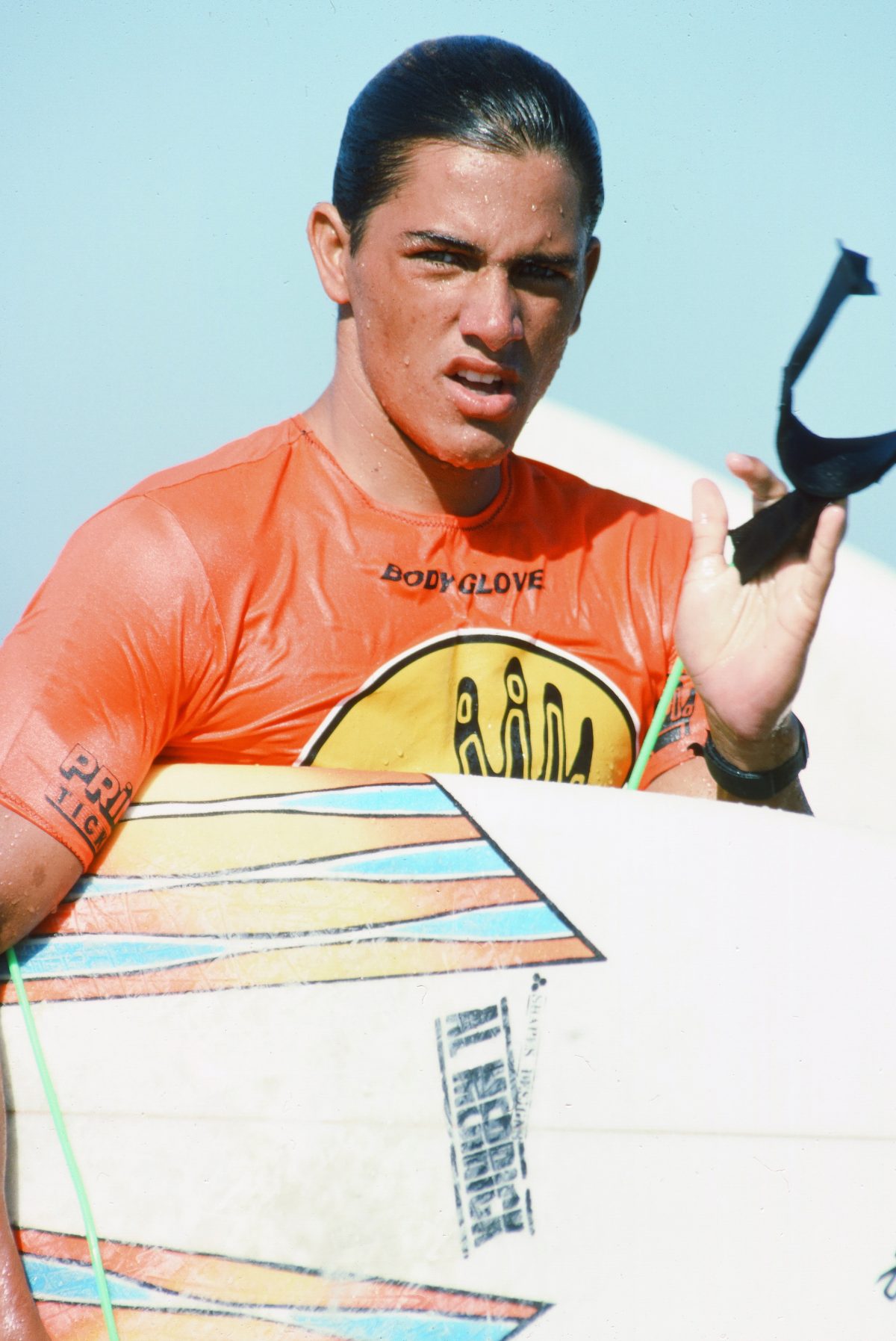
Kelly Slater at age 18, as he learned how best to attack Pipeline. Photo: Body Glove/Mike Balzer
I spent a lot of time watching guys like Dane Kealoha and Johnny-Boy Gomes and Ronnie Burns. Tom Carroll and Derek Ho also. All the guys who were great out there. Marvin Foster also. Anyone who charged and walked away seemed like a good guy to pay attention to. [At 18 he decided to paddle out on bigger boards so he could get more practice waves.] Bigger boards make the takeoff easier. When you can catch it from outside it just settles your nerves a bit. It makes riding the wave a bit less of a performance but builds confidence just being able to catch a few. Eventually at any lineup if you put yourself there enough and everyone is familiar with you you’re gonna get some of the best waves. It’s really just taking the time to pay your dues. [He gained more confidence in 1990 when he emerged unscathed from a wipeout that tossed him over Pipeline’s lip.] You can have a terrible situation on a small wave and an easy one on a big wave. You never know til you go and then you just deal with it.
Jock Sutherland
Tube-riding authority who first surfed Pipeline in the 1960s
I think I was 14 and I lived four or five miles away from Pipeline. I was a couple years away from getting my license but I had some friends who could drive. This was probably 1962 or 63. My buddies hauled me down there. This is when we all surfed longboards so I was probably surfing a 9-6 or 9-8 foam board. It was the one board I owned. It was not a very big day – maybe six feet, maybe occasional 8 foot. I’d already surfed big waves in other spots on the North Shore so I wasn’t too worried about the size. There weren’t many people out, if at all. The day was pretty-user friendly, so not a big fear factor, but after a few face-plantings you did come away with a sense of respect. And we were taught pretty quickly that there was a unique speed factor and that this was a wave of consequence.
“You get can hung up on the lip and you’re not going down the face, you’re going out – and that’s a very bad feeling.”
After I had ridden it about three or four times, I realized, ok, you can get really dusted here. I rode it on a little bit bigger days and got wiped out once or twice and it was pretty deeply impressed upon me how consequential it could be. I was on a wave in 1981 and delayed my turn because a friend was paddling out and the wave came over my shoulder and drove me into my board and broke my femur. When I go out to Pipe nowadays – which is not too often but there are user-friendly days — it’s nice to paddle out with my son because he knows all the young lions and everything’s cool. I can get a few waves and have a good time. And people will yell, “Go, Jock, go!” and that can be dangerous because you think, “I can do this, I can do this,” but if you don’t take that extra paddle or it’s a little too off-shore windy you get can hung up on the lip and you’re not going down the face, you’re going out – and that’s a very bad feeling.
Gavin Sutherland
Pro surfer, Jock Sutherland’s son
It was a nervous moment. I was like 13 or 14. Growing up with my dad being a legend and one of the first guys to surf it when it was big, that’s big boots to fill. But when you’re young, you really want to go out there and try it. It probably took a year of me checking it with my friends after school and then we all had to get up the courage to say, “You know, we’re just going to go out and do it.” It wasn’t big that day. It was six feet. Backdoor was working. There was a crowd out. You don’t want to look like an idiot in front of all the boys. I think I was surfing a Charlie Smith 6-8 or something. It was just a nice sunny morning and it was really inviting and it wasn’t super-super big and treacherous but big enough to get your heart racing.
“If your first session at Pipeline is a bad one and you’re sucked over the falls, you probably won’t want to go back to that very quickly.”
I paddled out with a buddy. There were heavies out that day – Johnny-Boy Gomes and Sunny Garcia. It was like, yikes, ok, those guys get the pick of the litter and we’ll just take these little scraps. I actually caught waves right off the bat. I just kind of started catching shoulders, little hop-overs, they kind of hop over the main peak and go toward the channel that has a sandbar, which is a little bit safer. So I had a great time. It wasn’t super-scary. It was actually a really great first session at Pipeline. If your first session at Pipeline is a bad one and you’re sucked over the falls, you probably won’t want to go back to that very quickly. But having a nice, medium-sized day and me catching a few waves definitely boosted my confidence. Of course, having my dad be a pioneer of Pipeline was also a confidence-booster. It’s in the genes so I know it’s possible.
Balaram Stack
New York pro surfer who rides Pipeline each winter
I had seen photos and videos but it wasn’t ever a wave I imagined surfing like I do now. It was just one of those famous spots you see the pros surf. I went over when I was 13 and ended up checking out Pipe for the first time. We paddled out and it was probably 4 to 6 foot. Big enough to see that there was a channel, which is where we sat the whole time and just watched. I was so blown away by this wave that breaks in the same spot every time. I hadn’t really traveled too much before that. Just the waves I grew up with in New York and on the East Coast. So just seeing it in person was crazy to me.
“There is always something crazy that happens.”
Reef (McIntosh) was a huge mentor. He would be the one who would tell me to go out on the days when no one was out and it was huge and he would paddle out with me. I only did that because Reef made me do it. It takes time to figure out how to get waves and how to deal with the crowd. It’s not like you are just surfing. People think it’s a lot easier than it is to go and do it. I see people who are little bit in over their head, I see people dropping in on people and it’s dangerous.
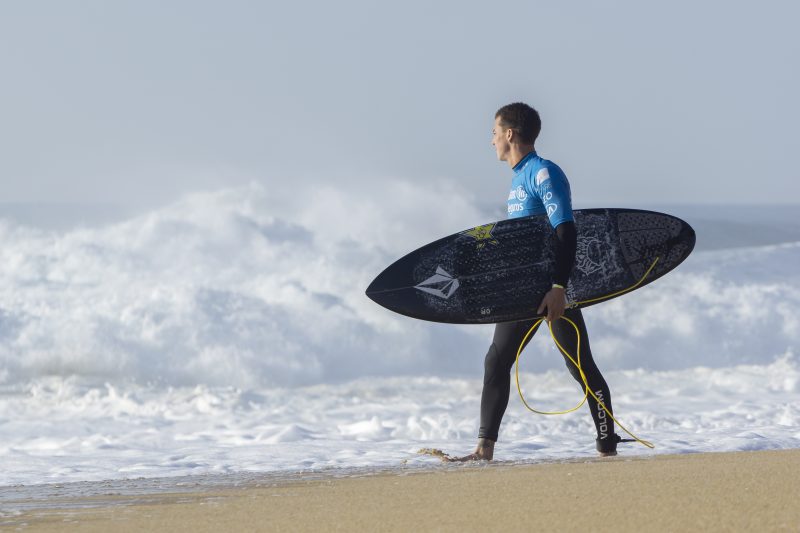
Balaram Stack: “I’ve gotten stitches here and there. There is always something crazy that happens.” Photo: Ricardo Santos Luis
Three or four years ago in the Volcom Pipe Pro I got a 10 in my second heat. It was probably the best thing that has ever happened to me in a contest. There is so much adrenaline. I remember coming out of the barrel and being oh my god that just happened. I was so baffled that it happened I couldn’t comprehend it until I saw it on video. It was big and perfect and spit me out. It’s a big powerful wave but you just take it for what it is and run with it. I’ve gotten stitches here and there. There is always something crazy that happens. I don’t try to focus on those times. Whatever happens happens. I just try to think about surfing. That’s it.
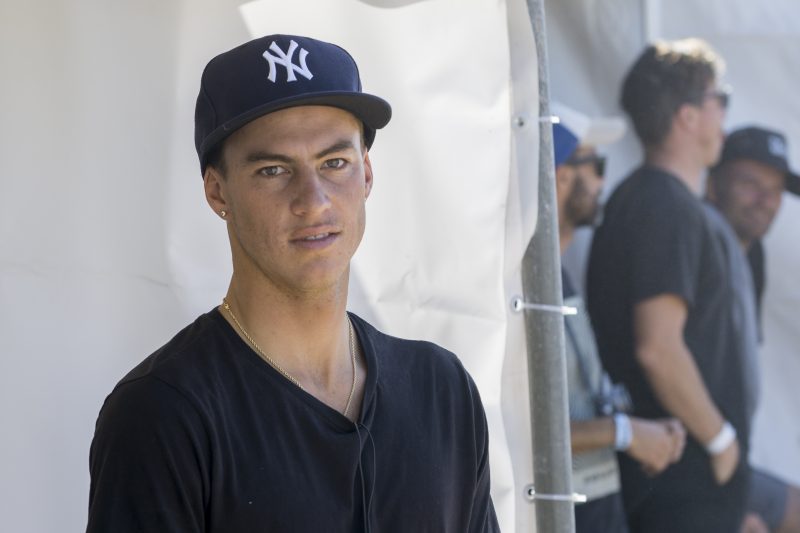
Balaram Stack lives in Manhattan but surfs Pipeline annually. “It wasn’t ever a wave I imagined surfing like I do now.” Photo: Ricardo Santos Luis
Gabriel Medina
First Brazilian to win a world surfing championship, in 2014
I was 13. When you’re a young boy like I was, you constantly dream of surfing Pipeline. I saw it in magazines, and I also saw my idols surfing that wave. So it was always my desire to surf there. I was thrilled and afraid at the same time. It’s a dangerous wave and any kind of mistake could be fateful. But I went there confident. I went with Miguel (Pupo, another Brazilian surfer), it was his 5th season already and (he) knew exactly how it worked. I didn’t know anybody. I just surfed by myself.
“I was thrilled and afraid at the same time.”
The first time I competed was in 2011. I was cautious, because it wasn’t the kind of wave I wanted to risk it all. I’ve fallen in many waves; I’ve taken a lot of wipeouts, but nothing serious. This year my goal is to win Pipe. In fact, this is a particular desire of mine. Two years in a row I almost did it. I hope it comes this year, otherwise, I’ll keep working on it.
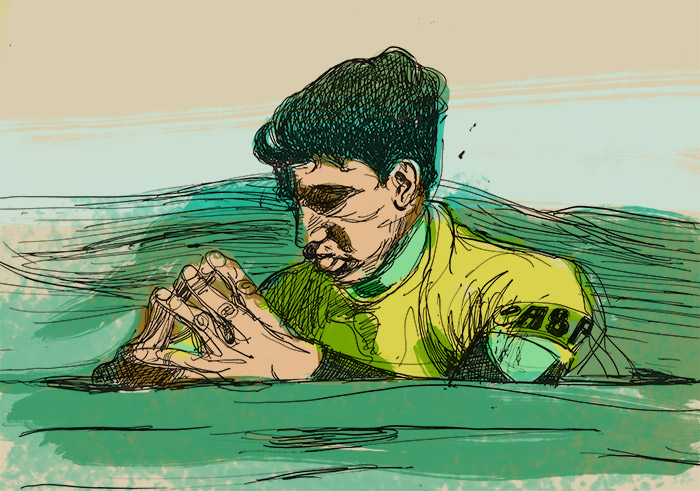
Gabriel Medina. Illustration by Alvar Sirlin.
Mickey Munoz
Pioneering surfer of the 1950s and 1960s
I’ve only ridden big Pipeline a few times. I might have been surfing a 9-foot board, maybe even a balsa board. There were only a handful of people that had ridden there. I was much better going right than left because I grew up on right-hand point breaks at Malibu and Rincon. So I started going right at Pipeline. That suited my style. And if there was a crowd at all at Pipeline, I’d go right because everybody was going left. You learn very early at Pipeline that if you commit, you better keep going. Better to keep going, even if you’ve made a mistake, because the wipe-outs are usually less than if at the least second, you go, oh shit, I screwed up, and now you get sucked over the falls and the wipe-outs are a lot worse. That was a severe lesson that you learned very quickly. Also, what I found is that you’re better taking off as far over in the pit as possible, even if you can’t make it. You don’t want to take off on the edge because at that point the wave is already going full-force and it’s going a lot faster than you are and you end up going over the falls. You do two or three mistakes and you say, ok, I get it, this is how I’m going to play it. Very possibly because of those lessons, that’s why I started going right.
“You learn very early at Pipeline that if you commit, you better keep going.”